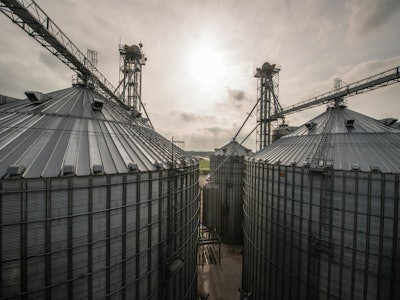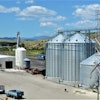
Photo: GSI
A well-planned grain system is essential to protect stored grain quality and promote efficiency.
Here are 10 key factors to consider when designing a new grain system.
- Build new or expand?— Commercial grain operations are often faced with the decision of expanding an existing grain system or building a new one. Expansion can be a good option if there’s adequate space and new components can be efficiently integrated with the existing equipment. On the other hand, capacity can be a limiting factor in many older systems. Sometimes it’s not financially feasible to expand an outdated system.
- Location— Take into consideration who’s your customer and what your proximity is to them. Is your primary customer a terminal elevator, ethanol plant, feed mill or farmers? Their proximity can have a significant impact on location. Also consider how the location will impact grain basis costs and if favorable railroad rates are available as well as your desired market share. These will all have an impact on the area you will need to draw grain from.
- Future expansion— Grain yields have been increasing in recent years, requiring more storage. Planning for that growth upfront will lead to better decisions about current as well as future equipment needs — including the number and capacity of grain bins, conveyors and dryers that will be needed. Always include additional space in the layout of a new system to accommodate more equipment as the operation grows. Also remember that space doesn’t do much good if you don’t’ have the infrastructure – natural gas and electric – to expand.
- Grains you will handle——有多少不同类型的谷物将facility handle and what are the different handling and storage characteristics for each grain handled? What are the aeration requirements of the grains? How will you fill and reclaim to minimize dockage and damage discounts and maximize revenue? Will grain drying be required? Also take into account your volume requirements of each grain type to service the market, customers and end users.
- Traffic patterns— Plan the grain system layout to ensure efficient traffic patterns for loading and unloading. The goal is to avoid bottlenecks. The worst thing is a semi stuck idling waiting to unload. Take time in the design phase to simulate loading and unloading in order to reduce potential delays.
- Speed and service– What will encourage a customer to bring or pull grain from your location instead of the competition? Consider how fast can you unload and load a truck, and if you will provide an RFID system to eliminate the hassle of scale tickets and grain settlements.
- Power— Three-phase power is needed for operating large machines and motors in today’s larger grain systems. It’s really a necessity for high-capacity dryers because of the large amount of grain being dried. In areas where three-phase power is not available, a phase convertor can be used to run three-phase motors and engines from existing single-phase power sources. Single-phase power may be sufficient for smaller grain systems, but more power may be needed to meet future growth.
- Be a good neighbor– It’s important to consider how your new grain handling facility can be a good neighbor. When siting a location take into consideration how noise, light and dust may impact your neighbors.
- Labor– What will be the labor requirements of the new facility or expansion? Consider solutions, such as automation, that can help replace labor.
- Profitability– Last but not least is your profitability. Make sure you know your operating costs and the revenue needed to meet your margin requirements. Also consider how much additional margin could be captured with automation.
For additional information, work with your grain system dealer. To learn more about GSI grain system equipment, visitgrainsystems.com.




